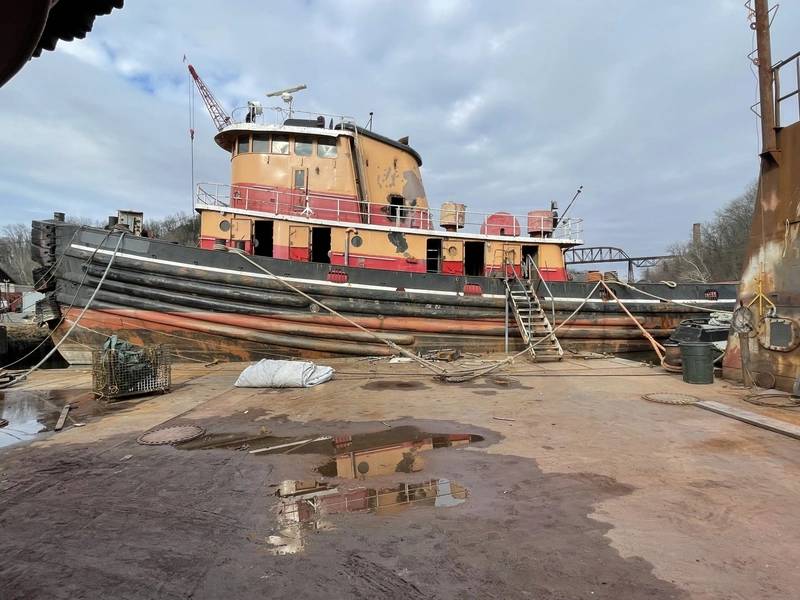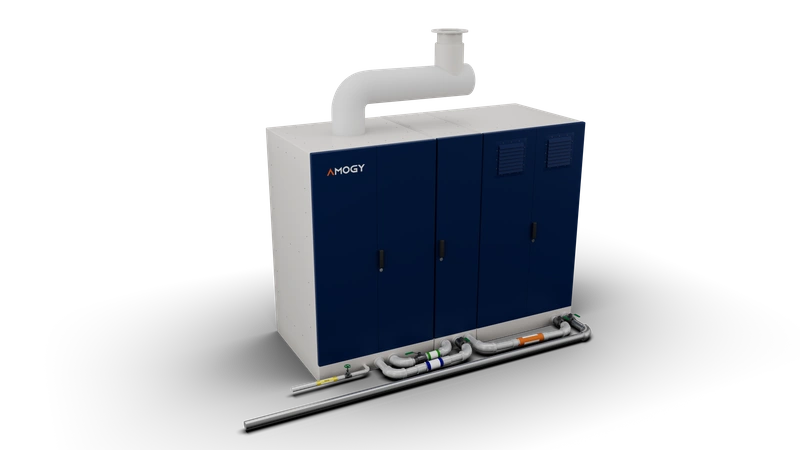Amogy Brings Ammonia Into the Mix
Ammonia is one of several renewable fuels seen as an option to help the maritime industry decarbonize.
One of the companies working to unlock the fuel’s potential is Brooklyn, N.Y. based Amogy, developer of an onboard system that feeds liquid ammonia through a cracking process to create hydrogen on demand for power generation via fuel cell—without carbon emissions.
Having already demonstrated its technology on an aerial drone, tractor and semi-truck, Amogy is currently working to retrofit a scaled up 1-megawatt (MW) version of its ammonia-to-power system onto a tug at Feeney Shipyard in Kingston, N.Y. as a test run for its emissions-slashing power and generation technology in the commercial maritime sector. If all goes according to plan, Amogy is targeting commercialization in 2024 and first commercial products ready for deployment in early 2025.
Helping to spearhead commercialization efforts is Anastasija Kuprijanova, Amogy’s director of maritime business development, who said collaboration will be key as the shipping industry works toward its net zero target.
“It's not an easy task to decarbonize a hard-to-abate sector; it's called hard-to-abate for a reason,” Kuprijanova said. “And that's the reason that all of us have to work together as an industry.”
As part of its tug demonstrator project, for example, Amogy is working with a number of commercial partners, including technology integrator SEAM, responsible for delivering the e-SEAMatic BLUE package. This includes the power system, integrated automation system, safety system, battery system, and electric motor for main propulsion.
The project is now well underway, SEAM said earlier this month, noting milestones such as completed factory acceptance tests (FAT) for the e-SEA Drive and AC switchboards, delivery of electric motor in collaboration with RAMME Electric Machines and supply of Orca batteries from Corvus.
Other partners involved in the project include ship designer C-Job Naval Architects and fuel supplier Yara Clean Ammonia. [Read more on this project in the April 2023 edition of Marine News.]
 Amogy is retrofitting its ammonia-to-power system on board a 1957-built tug at Feeney Shipyard in Kingston, N.Y. (Credit: Amogy)
Amogy is retrofitting its ammonia-to-power system on board a 1957-built tug at Feeney Shipyard in Kingston, N.Y. (Credit: Amogy)
Amogy has also branched out with a diverse range of partnerships aiming to explore possibilities for its technology in other parts of the market. In late 2022, Amogy announced a memorandum of understanding (MOU) with Southern Devall to deploy its technology in an ammonia tank barge.
Amogy also has an MOU with Green Ships and Bourbon Horizon have for the supply of its technology aboard platform supply vessels (PSV), as well as an MOU with Azane Fuel Solutions to explore the feasibility of using Amogy’s technology on board an Azane bunker vessel concept. Another MOU, with Norway’s Southwind, will see the partners explore opportunities in the offshore wind sector.
And in its first commercial order, Amogy has entered into a preorder contract to supply ammonia-to-power systems to an undisclosed Norwegian shipping company.
 “It's not an easy task to decarbonize a hard-to-abate sector; it's called hard-to-abate for a reason. And that's the reason that all of us have to work together as an industry.” - Anastasija Kuprijanova, Director of Maritime Business Development, Amogy. (Credit: Amogy)
“It's not an easy task to decarbonize a hard-to-abate sector; it's called hard-to-abate for a reason. And that's the reason that all of us have to work together as an industry.” - Anastasija Kuprijanova, Director of Maritime Business Development, Amogy. (Credit: Amogy)
While these partnerships demonstrate acceptance within the market, a challenge for Amogy has been reassuring potential users of its technology that the system will be safe to install and operate on board working commercial vessels. For some, ammonia can be jitters-inducing given the potential for catastrophe in the event of an onboard incident. When discussing the outlook for alternative fuels, the head of a large Texas shipyard recently described the prospect of using ammonia on board ships as “scary”.
When asked about the nervousness surrounding ammonia, Kuprijanova was quick to point out that the chemical has a long history of being safe handling and transport. “Ammonia is one of the most prominent chemicals in our day-to-day lives,” she said, noting the compound’s common use for refrigeration and within the agricultural sector. “Ammonia is used as a refrigerant at the International Space Station.”
“Ammonia is readily available in almost 200 ports worldwide. So, we have that industrial baseline that we can start to write a lot of safety protocols on.” Kuprijanova continued. “Of course, within the maritime industry, safety has to be part of our culture, and that's something that we take very near and dear in both our product development and our tugboat retrofit currently.”
Kuprijanova said Amogy is working closely with groups such as the Ammonia Safety Institute, the U.S. Coast Guard as well as ammonia suppliers and producers with baseline safety protocols that can be referenced as Amogy writes its own.
Amogy also recently completed its Technology Verification phase with Lloyd's Register as it continues to work with the classification society to complete the full Technology Qualification process ahead of commercial deployment.
“The good news is that the maritime industry is no stranger to ammonia,” Kuprijanova said. “There are a number of ammonia carriers already prominently available internationally. Domestically, we have a number of ammonia carrying barges, so marine crews are familiar with ammonia as a cargo. There will be additional steps to utilize it as a fuel, but I think that's something we'll certainly be able to get over as an industry by continuing to pave the way with some of these smaller projects like our tugboat demonstration and then really starting small and adopting big.”
 (Credit: Amogy)
(Credit: Amogy)
Kuprijanova stressed that the “energy transition” currently underway is far from the maritime industry’s first. “The industry has gone through a number of energy transitions—far more than many other forms of heavy-duty transportation—and every time it's been through in a hybrid approach.”
“The first steamship still had sails on them,” Kuprijanova said. “Every time that we've introduced new technology, we've still had a redundancy of something old on board. That was the case with the introduction of batteries, that's now the case with introduction of fuel cells, and that could also be the case with ammonia.”
Amogy’s “powerpacks” will be available in scalable 400-kilowatt modules that can be stacked to meet energy larger demands. First uses on board larger oceangoing ships will likely be for the supply of hotel power.
“We're specifically looking at providing support for auxiliary power or potentially replacing one diesel genset on board,” Kuprijanova said. “But as the technology continues to develop, as the innovation and regulatory hurdles continue to separate, and we have more guidance from the IMO, classification societies and coast guards, we certainly see this being a solution for main propulsion for larger scale oceangoing vessels.”












